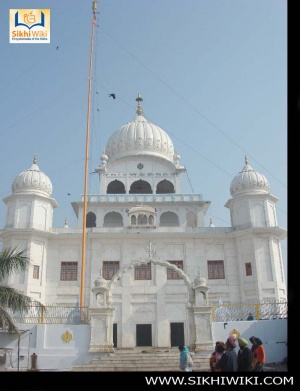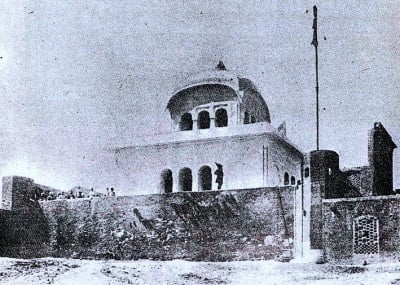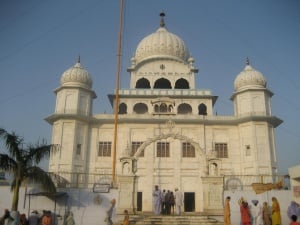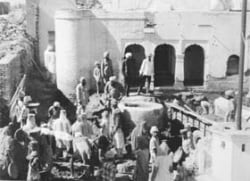Gurdwara Garhi Sahib
Gurdwara Garhi Sahib is situated in Chamkaur Sahib. The place commemorates the spot of the bloody battle of Chamkaur. After the attack at the river Sarsa, Guru Gobind Singh, his two eldest sons and 40 Sikhs made it to the town of Chamkaur while being pursued by an army of 1,000's. Guru Gobind Singh and the 40 Sikhs sought shelter in a mud-built double story house. They were attacked by the enemy on December 21, 1705.
Against these overwhelming odds, the Sikhs ventured our in small groups to fight the enemy and bravely lay down their lives. Thirty Seven Sikhs were martyred that day including Guru Gobind Singhs two eldest sons as well as three of the Five Beloved Ones (the first baptized Khalsa).
Guru Gobind Singh himself was preparing for battle and martyrdom, but the five remaining Sikhs in the fort enacted the scene at Anandpur, where they were had the authority of Guruship and Gobind Singh their Khalsa disciple. Quoting the Gurus words giving them authority to issue resolutions, they ordered Guru Gobind Singh to escape the fort at night followed by three of the five remaining Sikhs.
Location
Gurdwara Garhi Sahib is situated at Chamkaur Sahib in Ropar district and is connected by road to Ropar and Ludhiana-Chandigarh highway at Samrala and Morinda.
Gurdwara Garhi Sahib marks the site of the fortress like double storeyed house, with a high compound wall around it and only one entrance from the north, which was used by Guru Gobind Singh Ji as a temporary citadel in the unequal battle of Chamkaur on 7th December, 1705. While occupying the house during the night of 6-7 December, Guruji ordered 8 sikhs each to guard four sides.
While another two, Maan Singh and Kotha Singh was posted at the entrance. Guru Gobind Singh Ji, with his sons Ajit Singh and Jujhar Singh took position on the first floor of the house in the centre. Mughal now sorrounded the `Garhi'. The battle raged throughout the day. Sikhs started coming out in small batches to engage the enemy the hand to hand fight. Two such successive sallies were led by the Sahibzada Ajit Singh and Jujhar Singh, 18 and 14 years old respectively, who like the other sikhs fell fighting heroically.
Guru asked to leave the "fort"
By nightfall Guru Gobind Singh was left with only five sikhs in the fortress. These five sikhs urged him to escape so that he could rally his supporters again and continue the struggle against oppression. The Guruji agreed, he gave his own attire to Sangat Singh who resembled him in features and physical stature.
Under the cover of darkness Guruji made good his way through the encircling host slackened by the fatique of the day's battle. Daya Singh, Dharam Singh and Man Singh also escaped leaving behind only two sikhs, Sangat Singh and Sant Singh. Next day when, imperial trops entered the garhi, they were surprised to find only two occupants, who died rather than giving in. This place is also known as Tilak Asthan (Anointment Site) in the belief that Guru Gobind Singh Ji obeyed the five sikh here and gave his dress to Bhai Sangat Singh.
Salana Jor Mela and Dussehra are celebrated here.
The old Gurdwara building has since been demolished and replaced by a four storeyed structure. The sanctum is on the ground floor in the centre of a large divan hall. The building is topped by a lotus dome covered with chips of glazed tiles. There are decorative domed pavilions over the corners and walls of the main hall.
Contact
Gurdwara Garhi Sahib, Chamkaur Sahib, Ropar, Punjab
Phone: 01881-260289
News report
Monuments of Guru Gobind Singh’s time no longer there
Report by Sarbjit Dhaliwal for Tribune News Service Chamkaur Sahib, December 19, 2004
When lakhs of Sikhs from across the globe will congregate here tomorrow to pay tributes to the two elder Sahibzadas of Guru Gobind Singh and other “Singhs” on the historic occasion of the 300th anniversary of their martyrdom, they will also come to know how the SGPC has wiped out the great historical monuments associated with the wars fought by the Guru, his Sahibzadas and followers. Thousands of Sikhs have already reached here.
All historical buildings, including Chamkaur-de-Garhi, also famed as Kachhi Garhi, from where Guru Gobind Singh, his two elder Sahibzadas and other “Singhs” fought a great war against the armies of Turks and Pahari Rajas (Rulers of hill states), have been removed from the scene over the years. They have been replaced by modern Gurdwaras made of marble.
Many of the Sikhs turning up here will like to see the original Garhi (fortress) but it will be a disappointing moment for them when they will not be able to see such a structure in the town where Guru Gobind Singh spent two most crucial days — December 20 and 21 in 1704 — of his life. There is also no trace of the war field where the battle was actually fought as Gurdwara Katalgarh Sahib has come up there. Some say that instead of Katalgarh Sahib, it should be named as Gurdwara Shaheedan.
No trace of the original history of the Guru’s period has been left by those who were made the custodians of the Sikh heritage. All old buildings surrounding the original Garhi have also been demolished to build a new gurdwara. “Future generations would never forgive those who have played havoc with the Sikh heritage,” says a Sikh historian.
The Garhi belonged to Rai Sahib Chaudhary Roop Chand and his brother Chaudhary Jagat Singh. They were Rajputs, who migrated from Amber near Jaipur in 1134. Their elders were granted rights over 65 villages in the Chamkaur Sahib belt by rulers of that time.
Chaudhary Roop Chand’s descendants — Mohinder Singh, his son Bhup Chand and his grandson Arjan Singh — now live here at a short distance from Gurdwara Garhi Sahib. Mohinder Singh is from the sixth generation of Roop Chand. Mohinder Singh’s brother Krishan Kumar and his son Bhim Singh also live here.
There is no dependable historical date available with regard to the arrival of Guru Gobind Singh, his two elder sons and other armed Singhs in the Garhi. Seventy-year-old Mohinder Singh says that Chaudhary Roop Chand was a regular visitor to the Naina Devi temple, at a short distance from Anandpur Sahib. On way to Naina Devi and back, Chaudhary Roop Chand used to pay respects to Guru Gobind Singh, who was camping in the Anandpur Sahib fort. He says that Chaudhary Roop Chand had good relations with the Guru.
After marching out from the Anandpur Sahib fort, Guru Gobind Singh arrived at Chamkaur Sahib on December 20, 1704, and camped in a bagh (garden) that belonged to the Chaudhary family. At that place now, Gurdwara Dumdama Sahib has been built. From the bagh, the Guru and his men shifted to the Garhi to launch a counter attack on the invading armies of Turks and hill states. In the war, that continued for two days, the two elder Sahibzadas — Ajit Singh (16) and Jujhar Singh (14) — attained martyrdom along with three — Bhai Mohkam Singh, Bhai Himmat Singh and Bhai Sahib Singh — of the famed Panj Piaras.
Chaudhary Mohinder Singh and other members of his family say that their forefathers had helped the Guru and his followers to shift to the Garhi despite the fact that they were under pressure from the rulers of that time. “Historians have not done justice with our elders and a wrong picture has been painted of them,” they say. Chaudharys lost the ownership of 65 villages in 1852 when the land of these villages was allotted to muhjaras (serfs) by an officer, Kala Rai. But this town even now has a significant presence of the Chaudhary families.




